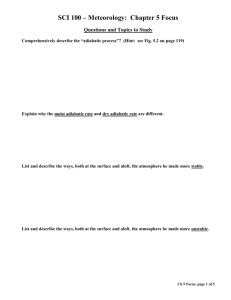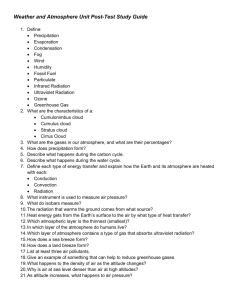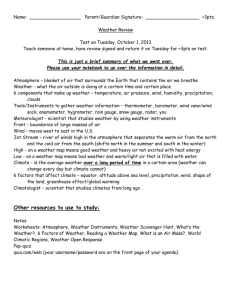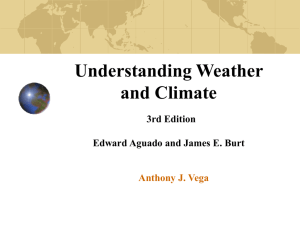Meteorology 1. The Structure of the Atmosphere Students will... 1.1
advertisement
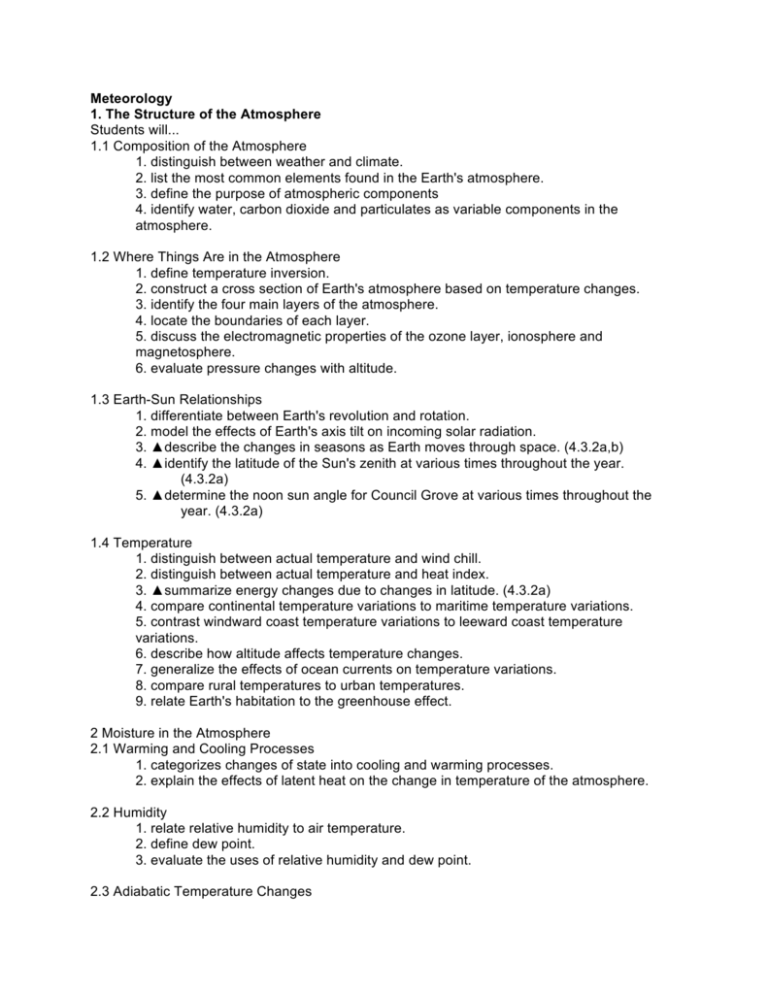
Meteorology 1. The Structure of the Atmosphere Students will... 1.1 Composition of the Atmosphere 1. distinguish between weather and climate. 2. list the most common elements found in the Earth's atmosphere. 3. define the purpose of atmospheric components 4. identify water, carbon dioxide and particulates as variable components in the atmosphere. 1.2 Where Things Are in the Atmosphere 1. define temperature inversion. 2. construct a cross section of Earth's atmosphere based on temperature changes. 3. identify the four main layers of the atmosphere. 4. locate the boundaries of each layer. 5. discuss the electromagnetic properties of the ozone layer, ionosphere and magnetosphere. 6. evaluate pressure changes with altitude. 1.3 Earth-Sun Relationships 1. differentiate between Earth's revolution and rotation. 2. model the effects of Earth's axis tilt on incoming solar radiation. 3. ▲describe the changes in seasons as Earth moves through space. (4.3.2a,b) 4. ▲identify the latitude of the Sun's zenith at various times throughout the year. (4.3.2a) 5. ▲determine the noon sun angle for Council Grove at various times throughout the year. (4.3.2a) 1.4 Temperature 1. distinguish between actual temperature and wind chill. 2. distinguish between actual temperature and heat index. 3. ▲summarize energy changes due to changes in latitude. (4.3.2a) 4. compare continental temperature variations to maritime temperature variations. 5. contrast windward coast temperature variations to leeward coast temperature variations. 6. describe how altitude affects temperature changes. 7. generalize the effects of ocean currents on temperature variations. 8. compare rural temperatures to urban temperatures. 9. relate Earth's habitation to the greenhouse effect. 2 Moisture in the Atmosphere 2.1 Warming and Cooling Processes 1. categorizes changes of state into cooling and warming processes. 2. explain the effects of latent heat on the change in temperature of the atmosphere. 2.2 Humidity 1. relate relative humidity to air temperature. 2. define dew point. 3. evaluate the uses of relative humidity and dew point. 2.3 Adiabatic Temperature Changes 1. explain adiabatic cooling of an air parcel. 2. identify the lifted condensation level of an air parcel. 3. determine the temperature change of an air parcel that is lifted. 2.4 Lifting Mechanisms 1. Identify the four mechanisms that causes vertical lifting of air (orographic lifting, frontal wedging, convergence, localized convective lifting). 2.5 Cloud Types 1. identify clouds by form (cirrus, cumulus, stratus). 2. identify clouds by altitude (cirro, alto, stratus). 3. identify vertical clouds (nimbus, cumulonimbus) 2.6 Precipitation 1. describe the formation of ice crystals during the cold cloud process (Bergeron process). 2. explain how the warm cloud process (collision-coalescence) results in precipitation. 3. compare and contrast the various types of precipitation (rain, snow, sleet, hail, glaze). 4. describe the formation of each type of precipitation. 5. distinguish between the different types of fog (advection, radation, upslope, steam, precipitation). Weather Station Models 1. identify various weather data given on a station model (temperature, dew point, pressure, pressure trend, cloud cover, wind speed, wind direction, current weather). 2. decode station models to present weather at a particular location. 3. create station models to represent weather at a particular location. Air Pressure and Wind 3.1 Pressure 1. describe how air pressure is exerted on an object. 2. distinguish between various methods of reporting air pressure (millibars, in Hg, atm) 3. create isobars given a map of local air pressure readings. 4. summarize the factors that influence air motion. 5. relate Earth's unequal surface heating to the regional horizontal pressure gradient. 6. use isobars to visualize horizontal pressure gradients over an area. 7. describe how the Coriolis effect influences freely moving objects. 8. distinguish between geostrophic flow and ageostrophic flow. 3.2 Pressure Centers and winds 1. explain how winds blow around pressure centers in the Northern and Southern hemispheres. 2. describe the air pressure patterns within cylcones and anticyclones. 3. use Buys Ballot's Law to locate centers of high and low pressures. 3.3 Global Winds 1. explain how the unequal heating of Earth's surface affects the atmosphere. 2. using the non-rotating Earth model, distinguish six atmospheric convection cells that result from surface heating. 3. describe the wind belt associated with each convection cell when the Earth's rotation is taken into account. 4. explain how continents influence global wind patterns. 4 Weather Patterns 4.1 Air Masses 1. define air mass. 2. explain how air masses are classified. 3. describe the characteristics associated with each air mass type. 4. explain the influence of continental polar and maritime tropical air masses on the majority of North America. 4.2 Fronts 1. describe the formation of a front. 2. differentiate among the formation of a warm front, cold front, occluded front and stationary front. 3. describe the weather patterns associated with each type of front. 4. identify frontal boundaries on a map of regional temperature data. 4.3 Mid-Latitude Cyclone 1. recognize the importance of mid-latitude cyclones in the weather patterns found in Kansas. 2. describe the early stage of a mid-latitude cyclone and its associated weather. 3. describe the open stage of a mid-latitude cyclone and its associated weather. 4. describe the mature stage of a mid-latitude cyclone and its associated weather. 5. describe the occluding stage of a mid-latitude cyclone and its associated weather. 6. describe the dissolving stage of a mid-latitude cyclone and its associated weather. 5 Severe Weather 5.1 Thunderstorms 1. describe the cumulus stage of a thunderstorm. 2. describe the mature stage of a thunderstorm. 3. describe the dissipating stage of a thunderstorm. 4. explain the conditions necessary for hail to form. 5. explain the conditions necessary for lighting to form. 6. discuss thunderstorm safety. 5.2 Severe Thunderstorms 1. identify the characteristics that make a thunderstorm severe. 2. explain the double vortex model of a severe thunderstorm. 3. describe the various systems that can produce severe thunderstorms (squall line, mesoscale convective complex, multi-cell, super-cell). 5.3 Tornadoes 1. describe the conditions required for a tornado to form. 2. explain how horizontal tubes form into a tornado. 3. explain how a mesocyclone develops into a tornado. 4. identify a wall cloud. 5. identify radar products that indicate a tornado. 6. use the Enhanced Fujita scale to estimate the size of a tornado. 5.4 Hurricanes


